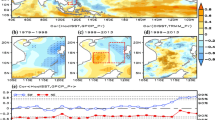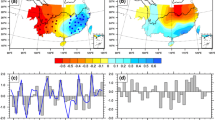Abstract
This study investigates summer rainfall variability in the South China Sea (SCS) region and the roles of remote sea surface temperature (SST) forcing in the tropical Indian and Pacific Ocean regions. The SCS summer rainfall displays a positive and negative relationship with simultaneous SST in the equatorial central Pacific (ECP) and the North Indian Ocean (NIO), respectively. Positive ECP SST anomalies induce an anomalous low-level cyclone over the SCS-western North Pacific as a Rossby-wave type response, leading to above-normal precipitation over northern SCS. Negative NIO SST anomalies contribute to anomalous cyclonic winds over the western North Pacific by an anomalous east–west vertical circulation north of the equator, favoring more rainfall over northern SCS. These NIO SST anomalies are closely related to preceding La Niña and El Niño events through the “atmospheric bridge”. Thus, the NIO SST anomalies serve as a medium for an indirect impact of preceding ECP SST anomalies on the SCS summer rainfall variability. The ECP SST influence is identified to be dominant after 1990 and the NIO SST impact is relatively more important during 1980s. These Indo-Pacific SST effects are further investigated by conducting numerical experiments with an atmospheric general circulation model. The consistency between the numerical experiments and the observations enhances the credibility of the Indo-Pacific SST influence on the SCS summer rainfall variability.











Similar content being viewed by others
References
Adler RF, Huffman GJ, Chang A et al (2003) The version 2 global precipitation climatology project (GPCP) monthly precipitation analysis (1979-present). J Hydrometeor 4:1147–1167
Chen JP, Wu R, Wen ZP (2012) Contribution of South China Sea tropical cyclones to an increase in southern China summer rainfall around 1993. Adv Atmos Sci 29(3):585–598
Chen Z, Wen ZP, Wu R, Zhao P, Cao J (2014a) Influence of two types of El Niños on the East Asian climate during boreal summer: a numerical study. Clim Dyn. doi:10.1007/s00382-013-1943-1
Chen JP, Wen ZP, Wu R, Chen Z, Zhao P (2014b) Interdecadal changes in the relationship between Southern China winter-spring precipitation and ENSO. Clim Dyn. doi:10.1007/s00382-013-1947-x
Collins WD, Rasch PJ, Boville BA et al (2006) The formulation and atmospheric simulation of the Community Atmosphere Model version 3 (CAM3). J Clim 19:2144–2161
Cook KH, Meehl GA, Arblaster JM (2012) Monsoon regimes and processes in CCSM4, part 2: African and American monsoon systems. J Clim 25(8):2609–2621
Ding YH (1994a) Asian monsoon. China Meteorological Press, Bei**g, pp 105–113 (in Chinese)
Ding YH (1994b) Monsoons over China. Kluwer Academic, Dordrecht
Eaton B (2012) User’s guide to the Community Atmosphere Model CAM-5.1.1. NCAR. http://www.cesm.ucar.edu/models/cesm1.0/cam/docs/ug5_1_1/ug.html
He ZQ, Wu R (2013a) Coupled seasonal variability in the South China Sea. J Oceanogr 69(1):57–69
He ZQ, Wu R (2013b) Seasonality of interannual atmosphere–ocean interaction in the South China Sea. J Oceanogr 69(6):699–712
Hoerling MP, Kumar A, Zhong M (1997) El Niño, La Niña, and the nonlinearity of their teleconnections. J Clim 10:1769–1786
Huffman GJ, Adler RF, Bolvin DT, Gu G (2009) Improving the global precipitation record: GPCP version 2.1. Geophys Res Lett 36:L17808. doi:10.1029/2009GL040000
Kanamitsu M, Ebisuzaki W, Woollen J, Yang SK, Hnilo JJ, Fiorino M, Potter GL (2002) NCEP-DEO AMIP-II reanalysis (R-2). Bull Atmos Meteorol Soc 83:1631–1643
Kay JE, Hillman BR, Klein SA et al (2012) Exposing global cloud biases in the Community Atmosphere Model (CAM) using satellite observations and their corresponding instrument simulators. J Clim 25:5190–5207
Klein SA, Soden BJ, Lau NC (1999) Remote sea surface temperature variations during ENSO: evidence for a tropical atmospheric bridge. J Clim 12:917–932
Larkin NK, Harrison DE (2002) ENSO Warm (El Niño) and Cold (La Niña) event life cycles: ocean surface anomaly patterns, their symmetries, asymmetries, and implications. J Climate 15:1118–1140
Lau NC, Nath MJ (2003) Atmosphere–ocean variations in the Indo-Pacific sector during ENSO episodes. J Clim 16:3–20
Li CY, Zhang LP (1999) Summer monsoon activities in the South China Sea and its impacts. Chin J Atmos Sci 23(3):257–266 (in Chinese)
Li S, Lu J, Huang G, Hu K (2008) Tropical Indian Ocean basin warming and East Asian summer monsoon: a multiple AGCM study. J Clim 21:6080–6088
Lindzen RS, Nigam S (1987) On the role of sea surface temperature gradients in forcing low-level winds and convergence in the tropics. J Atmos Sci 44(17):2418–2436
Liu QY, Jiang X, **e SP, Liu WT (2004) A gap in the Indo-Pacific warm pool over the South China Sea in boreal winter: seasonal development and interannual variability. J Geophys Res 109:C07012. doi:10.1029/2003JC002179
Meehl GA, Arblaster JM, Caron JM et al (2012) Monsoon regimes and processes in CCSM4, part 1: the Asian–Australian monsoon. J Clim 25(8):2583–2608
Muñoz E, Weijer W, Grodsky SA et al (2012) Mean and variability of the tropical Atlantic Ocean in the CCSM4. J Clim 24(14):4860–4882
Neale RB, Richter J, Park S et al (2013) The mean climate of the Community Atmosphere Model (CAM4) in forced SST and fully coupled experiments. J Clim 26(14):5150–5168
Reynolds RW, Rayner NA, Smith TM, Stokes DC, Wang W (2002) An improved in situ and satellite SST analysis for climate. J Clim 15:1609–1625
Tao SY, Chen LX (1987) A review of recent research of the East Asian summer monsoon in China. In: Chang CP, Krishnamurti TN (eds) Monsoon meteorology. Oxford University Press, Oxford, pp 60–92
Vertenstein M, Craig T, Middleton A, Feddema D, Fischer C (2011) CESM1. 0.4 user’s guide. NCAR. http://www.cesm.ucar.edu/models/cesm1.0/cesm/cesm_doc_1_0_4/x42.html
Wang B, Zhang Q (2002) Pacific-East Asian teleconnection part II: how the Philippine Sea anomalous anticyclone is established during El Niño development. J Clim 15:3252–3265
Wang B, Wu R, Fu X (2000) Pacific-East Asian teleconnection: how does ENSO affect East Asian climate? J Clim 13:1517–1536
Wang B, Wu R, Li T (2003) Atmosphere–Warm Ocean interaction and its impacts on Asian–Australian monsoon variation. J Clim 16:1195–1211
Wang CZ, Wang WQ, Wang DX, Wang Q (2006) Interannual variability of the South China Sea associated with El Niño. J Geophys Res 111:C03023. doi:10.1029/2005JC003333
Wang GH, Su JL, Ding YH, Chen D (2007) Tropical cyclone genesis over the South China Sea. J Mar Syst 68:318–326
Wu R, Kirtman BP (2007) Regimes of local air-sea interactions and implications for performance of forced simulations. Clim Dyn 29:393–410
Wu R, Kirtman BP (2011) Caribbean Sea rainfall variability during the rainy season and relationship to the equatorial Pacific and tropical Atlantic SST. Clim Dyn 37(7–8):1533–1550
Wu R, Wang B (2000) Interannual variability of summer monsoon onset over the western North Pacific and the underlying processes. J Climate 13:2483–2501
Wu GX, Li JP, Zhou TJ et al (2006) The key regions affecting the short-term climate variations in China: the joining area of Asia and Indian-Pacific Ocean. Adv Earth Sci 21(11):1109–1118 (in Chinese)
Wu R, Wen ZP, Yang S, Li Y (2010) An interdecadal change in southern China summer rainfall around 1992/93. J Clim 23(9):2389–2403
Wu R, Chen J, Chen W (2012) Different types of ENSO influences on the Indian summer monsoon variability. J Clim 25(3):903–920
Wu R, Huang G, Du Z, Hu K (2014) Cross-season relation of the South China Sea precipitation variability between winter and summer. Clim Dyn. doi:10.1007/s00382-013-1820-y
**e SP, Hu K, Hafner J et al (2009) Indian Ocean capacitor effect on Indo-Western Pacific climate during the summer following El Niño. J Clim 22:730–747
Yang J, Liu Q, **e SP, Liu Z, Wu L (2007) Impact of the Indian Ocean SST basin mode on the Asian summer monsoon. Geophys Res Lett 34:L02708. doi:10.1029/2006GL028571
Yu L, ** X, Weller RA (2008) Multidecade global flux datasets from the Objectively Analyzed Air–sea Fluxes (OAFlux) project: latent and sensible heat fluxes, ocean evaporation, and related surface meteorological variables. OAFlux project technical report, OA-2008-01
Zhang Y, Rossow WB, Lacis AA, Oinas V, Mishchenko MI (2004) Calculation of radiative fluxes from the surface to top of atmosphere based on ISCCP and other global data sets: refinement of the radiative transfer model and the input data. J Geophys Res 109:D19105. doi:10.1029/2003JD00445
Zhou TJ, Yu RC (2005) Atmospheric water vapor transport associated with typical anomalous summer rainfall patterns in China. J Geophys Res 110:D08104. doi:10.1029/2004JD005413
Acknowledgments
This study is supported by the National Basis Research Program of China grant (2014CB953902), the Hong Kong Research Grant Council Grant (CUHK403612), and the National Natural Science Foundation of China Grant (41275081).
Author information
Authors and Affiliations
Corresponding author
Rights and permissions
About this article
Cite this article
He, Z., Wu, R. Indo-Pacific remote forcing in summer rainfall variability over the South China Sea. Clim Dyn 42, 2323–2337 (2014). https://doi.org/10.1007/s00382-014-2123-7
Received:
Accepted:
Published:
Issue Date:
DOI: https://doi.org/10.1007/s00382-014-2123-7




